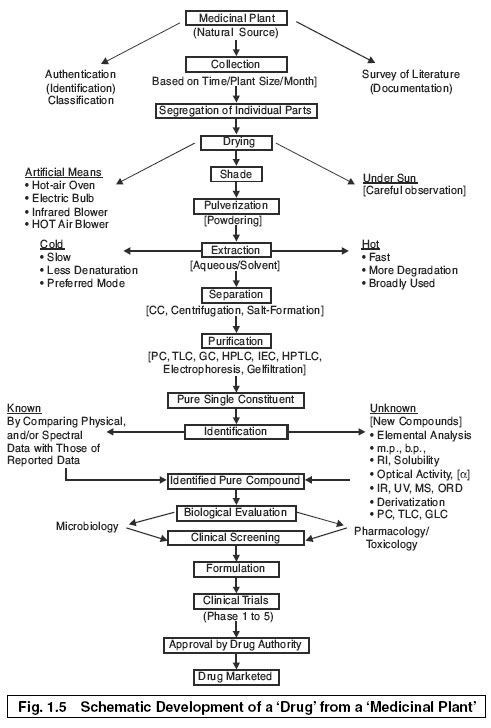4 PHYTOCHEMISTRY
‘Phytochemistry’ or the ‘Chemistry of Natural Products’ may be strategically placed somewhere in between natural product organic chemistry and plant biochemistry. In fact, it is intimately related to the above two disciplines. However, in a broader sense phytochemistry essentially deals with the enormous different types of organic substances that are not only elaborated but also accumulated by plants. It is solely concerned with the following various aspects namely:
* Natural distribution.
* Chemical structure,
* Biosynthesis structure,
* Biosyntheses (or biogenesis),
* Metabolism, and
* Biochemical function.
Importantly, with the advent of most up-to-date analytical procedures the detailed phytochemical
study of an unknown plant may be accomplished right from elucidation of chemical structure of pure constituents to the elaborated study of their biological characteristics.
Figure 1.5, illustrates the schematic development of a ‘drug’ from a ‘medicinal plant’ that may serve as a fruitful guide for various phytochemistry studies:
It is, however, important to mention here that the ‘living organism’ of the universe (i.e.; plants, microbes and animals) may be regarded as mother nature‘s splendid and huge BIOSYNTHETIC LABORATORY. It not only caters for the survival of the so called ‘living creatures’ of the earth in terms of providing a broad spectrum of essential chemical constituents, for instance: proteins, fats, carbohydrates and vitamins but also meticulously bring forth an enormous quantum of physiologically active chemical entities, such as: alkaloids, glycosides, volatile oil (terpenoids), steroids, antibiotics, bitter principles, tannins and the like. The ‘living organisms’ give rise to a number of interesting phytochemical aspects over the years that may be viewed closely under the following three heads, namely:
(i) Constituents,
(ii) Drug Biosynthesis (or Biogenesis) and
(iii) Classification
REFERENCES
Ashutosh Kar (2003), Pharmacognosy and Pharmaco biotechnology, 2nd Edition
‘Handbook of Medicinal Herbs’ (2001), J.A. Duke, CRC-Press, London, 1st Edn.
William Charles Evans (2002), Trease and Evans Pharmacognosy 15th Edition by: Trease, Bailliere Tindall; Evans.
Ramstad (1956), E., ‘Modern Pharmacognosy’, McGraw Hill, London.








